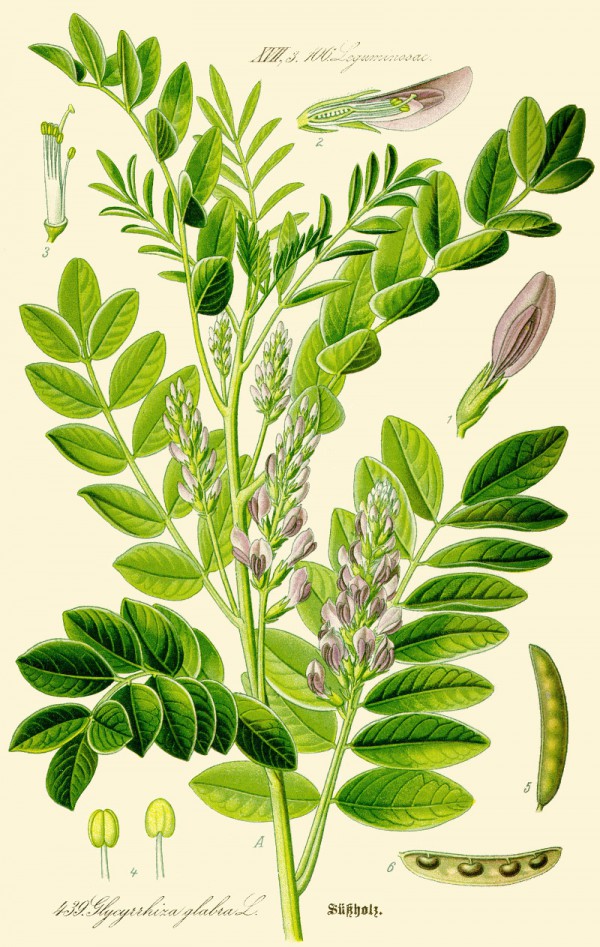Glycyrrhiza glabra L. - Fabaceae - liquorice, sweet wood, Lakritze, Kahles Süßholz
Perennial herb, up to 1m tall; native to South and Southeast Europe, West Sibiria, West Asia, North Africa.
Royal Botanical Gardens Kew: Glycyrrhiza glabra L.
After the harvest of the roots in autumn, they are cutted and cooked to pulp and filtered. The
resulting syrup solidifies to form a solid mass, which is broken down to black-brown pieces, the basic substance of licorice… The sweet taste of the root is due to the triterpene saponin glycyrrhizin (glycyrrhizic acid or glycyrrhizinic acid, sweetening power 50 times greater than sugar).
http://www.botanik-bochum.de/jahrbuch/Pflanzenportraet_Glycyrrhiza_glabra.pdf
For the production of licorice sweets, flour paste is mixed with sugar, corn syrup, thickened liquorice juice and gelatin, then thickened and dried. Licorice products contain starch (30-45%), sucrose (30-40%), and more than 5% of licorice extract. Products of higher quality are made with up to 30% of licorice extract.
[Lehrbuch der Lebensmittelchemie, Belitz, H.D., Grosch, W., Schieberle, P., Berlin Heidelberg New York, 2001, 911]
The dried rhizomes (Liquiritiae radix) and extract are used since ancient times to treat chronic gastric and duodenal ulcera, gastritis, epigastric bloating, faltulence, and diseases of the upper respiratory tract like bronchitis and cough. The extract is also employed as sweetening agent to hide the unpleasant taste of pharmaceutical preparations.
[Medicinal Plants of the World. Ben-Erik Van Wyk and Michael Wink, Pretoria 2004, 160]
„Aqueous extracts from the roots of Glycyrrhiza glabra L. (Fabaceae) are widely used for treatment of stomach ulcer. The clinical proven effects are related to the presence of anti-inflammatory 12-keto-triterpensaponins in the extracts. Apart from that the influence of Glycyrrhiza glabra extract on the bacterial adhesion of Helicobacter pylori to stomach tissue was to be investigated… Aqueous extract (1 mg/mL) of Glycyrrhiza glabra significantly inhibited the adhesion of Helicobacter pylori to human stomach tissue. This effect was related to the polysaccharides isolated from the extract, with one purified acidic fraction (0.25 SPB) as main active polymer.“
[Aqueous extracts and polysaccharides from liquorice roots (Glycyrrhiza glabra L.) inhibit adhesion of Helicobacter pylori to human gastric mucosa., Wittschier, N., Faller, G., Hensel, A., Journal of ethnopharmacology, 125(2), 2009, 218-223]
„Frattini and others (1977) reported a change in G. glabra volatiles composition in response to heating, compared to unheated licorice. Most abundant compounds were acetol, propionic acid, 2-acetyl-pyrrole, 2-acetyl-furan, and with furan derivatives most common due to pyrolysis of sugars enriched in licorice. Several phenolics and terpenoids were also characterized as aroma volatiles in licorice juice that were not detected in
heated samples …
The qualitative composition of G. glabra essential oils from different origins was relatively similar with phenols and ketones, that is, thymol and piperitone, as characteristic constituents. Aldehydes constitute the most dominant chemical group present in the three Glycyrrhiza species: G. glabra (17% to 30% aldehydes in volatile fraction), G. inflata (16%), and G. echinata (40% to 48%).“
Main components of G.glabra root essential oils were 5-methyl-furfural (3-10%), (4E)-decenal (3-5%), cumin aldehyde (1-4%), carvone (0-3%), piperitone (7-13%), (E)-cinnamaldehyde (3-6%), thymol (5-27%), carvacrol (1-11%), p-vinyl-guaiacol (8-9%), eugenol (7-9%) and methyl eugenol (0-3%), γ-nonalactone (1-7%), β-caryophyllene and its oxide.
[Volatiles Profiling in Medicinal Licorice Roots Using Steam Distillation and Solid‐Phase Microextraction (SPME) Coupled to Chemometrics. Farag, M. A., & Wessjohann, L. A. , Journal of food science, Vol.77(11), 2012, 1179-1184] http://scholar.cu.edu.eg/sites/default/files/mfarag73/files/farag_et_al._2012_journal_of_food_science.pdf
[Volatile flavor components of licorice. Journal of Agricultural and Food Chemistry. Frattini, C., Bicchi, C., Barettini, C., & Nano, G. M. (1977), Vol.25(6), 1977, 1238-1241]
„The hydroalcoholic extract of Glycyrrhiza glabra L. (HEGG) was evaluated for antiulcerogenic activity and acute toxicity profile in mice… G. glabra extract (50-150 mg/kg) showed antiulcer activity against indomethacin-induced gastric lesions dose dependently. The extract effectively inhibited formation of gastric lesions induced by ethanol. The extract (200 mg/kg) was more potent than omeprazole (30 mg/kg).“
[Antiulcer properties of Glycyrrhiza glabra L. extract on experimental models of gastric ulcer in mice., Jalilzadeh-Amin, G., Najarnezhad, V., Anassori, E., Mostafavi, M., Keshipour, H., Iranian Journal of Pharmaceutical Research, 2015]

Thomé,O.W., Flora von Deutschland Österreich und der Schweiz, Tafeln, vol.3 t.439 (1885)
http://plantgenera.org/species.php?id_species=470297